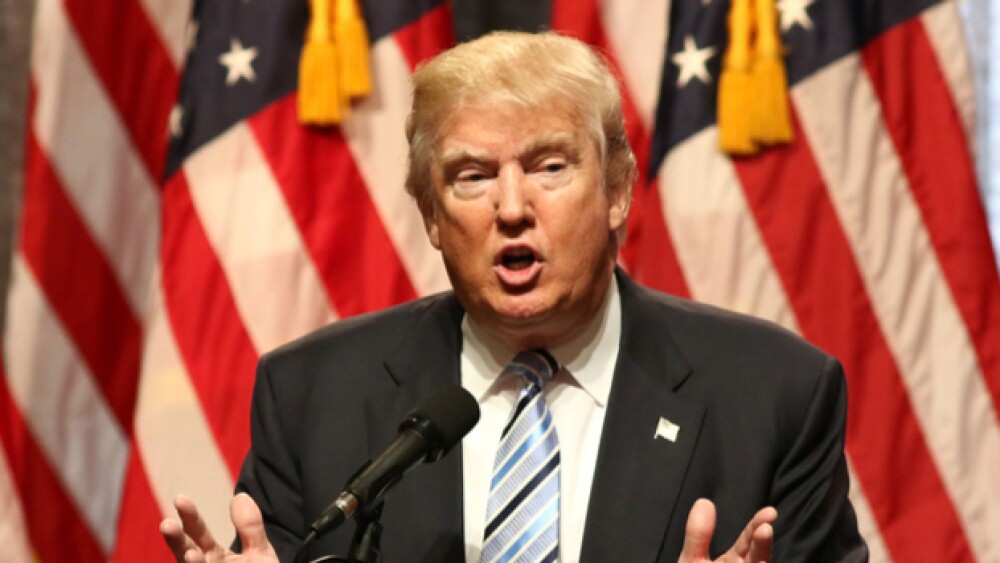“Hopefully the approval process will go very quickly, and we think we have a winner here,” Trump told White House reporters on Wednesday.
JStone/Shutterstock
After the U.S. Department of Health and Human Services (HHS) and the Department of Defense’s Operation Warp Speed program cut a $1.95 billion deal with Pfizer and BioNTech for production of their experimental COVID-19 vaccines, President Donald Trump referred to it as “a historic agreement.”
“Hopefully the approval process will go very quickly, and we think we have a winner here,” Trump told White House reporters on Wednesday. “We also think we have other companies right behind that are doing very well on the vaccines, long ahead of schedule.”
Operation Warp Speed (OWS) has a goal of delivering 300 million doses of a safe and effective vaccine against COVID-19 by January 2021. It is a partnership between HHS, the Centers for Disease Control and Prevention (CDC), the U.S. Food and Drug Administration (FDA), the National Institutes of Health (NIH), the Biomedical Advanced Research and Development Authority (BARDA), and the Department of Defense (DoD).
The project’s website says, “OWS engages with private firms and other federal agencies, including the Department of Agriculture, the Department of Energy, and the Department of Veterans Affairs. It will coordinate existing HHS-wide efforts, including the NIH’s Accelerating COVID-19 Therapeutic Interventions and Vaccines (ACTIV) partnership, NIH’s Rapid Acceleration of Diagnostics (RADx) initiative, and work by BARDA.”
The Pfizer and BioNTech deal is just the latest of several that Operation Warp Speed has funded. These include:
• March 30: $456 million in support of Johnson & Johnson’s candidate vaccine.
• April 16: $483 million for Moderna’s COVID-19 vaccine, which is in development with the NIH’s National Institute of Allergy and Infectious Diseases (NIAID).
• May 21: $1.2 billion for AstraZeneca’s vaccine in partnership with the University of Oxford.
Operation Warp Speed made an announcement on May 15, noting it had selected 14 promising candidates from more than 100 vaccine candidates, and those 14 were being narrowed down to about seven. Large-scale clinical trials were being launched for those trials.
In terms of manufacturing production, OWS, in addition to the Pfizer/BioNTech deal, also included production agreements with AstraZeneca, Moderna, and J&J, as well as a June 1 announcement with Emergent BioSolutions to increase domestic manufacturing capabilities and capacities for both COVID-19 vaccines and therapeutics. That deal was worth approximately $628 million.
If and when these vaccines are considered viable, Operation Warp Speed also is developing plans for widespread distribution efforts. They include a May 12 contract announcement worth $138 million with ApiJect for more than 100 million prefilled syringes by the end of this year as well as a production goal of more than 500 million in 2021; a June 9 domestic manufacturing capacity deal for vials for vaccines, with $204 million going to Corning with an a $143 million contract to SiO2 Materials Science to scale up capacity to manufacture glass-coated plastic containers.
The Pfizer-BioNTech will pay out $1.95 billion for 100 million doses of the experimental COVID-19 vaccine, with an agreement to buy up to 500 million more doses. Two weeks ago, on July 13, the two companies reported that two of their four vaccine candidates received Fast Track designation from the FDA. The two are BNT162b1 and BNT162b2 and are both currently in Phase I/II clinical trials in the U.S. and Germany.
Each of the four experimental vaccines are a unique combination of messenger RNA format and target antigen. The two Fast-Tracked are nucleoside modified RNAs formulated in lipid nanoparticles, which basically means they are engineered pieces of mRNA that are contained in a fat particle that is used as a delivery vector. BNT162b1 encodes an optimized SARS-CoV-2 receptor-binding domain antigen, while BNT162b2 encodes an optimized SARS-CoV-2 full-length spike protein antigen.
The two companies also reported a week later initial data from the German Phase I/II trial. It is published on the online preprint server at medRxiv and is currently being peer-reviewed for possible publication. This data is on BNT1621b1. The companies indicate the preliminary data supported and expands on early results from the recently disclosed early data from the US trial of BNT162b1.
The vaccine produced high, dose level-dependent neutralizing antibodies against SARS-CoV-2 and RBD-binding IgG concentrations after the second date. The titers of neutralizing antibodies were comparable to a group of convalescent antibody titers from patients who recovered from COVID-19. The companies stated, “Furthermore, sera of vaccinated subjects displayed broadly neutralizing activity in pseudovirus neutralization assays across a panel of sixteen SARS-CoV-2 RBD variants represented in publicly available SARS-CoV-2 sequences and against the newly dominant D614G strain.”
They also showed induction of high levels of CD4+ and CD8+ T cell responses. They found the strength of the T cell responses varied between patients and there was no clear dose level dependence between the level of doses, suggesting that that stimulation and robust expansion of T cells might be stimulated at low mRNA dose levels.





